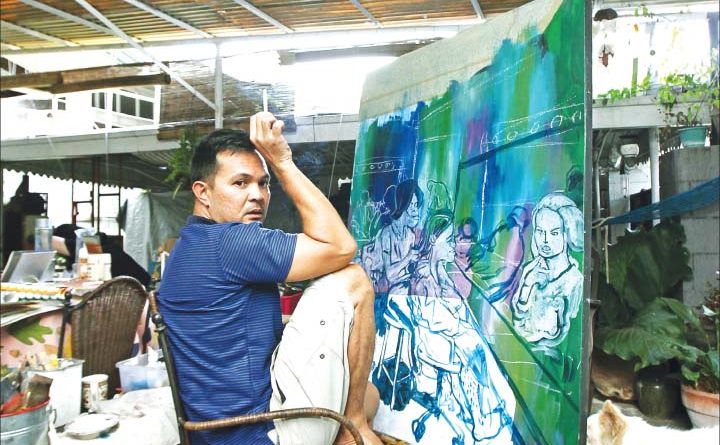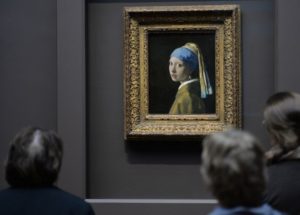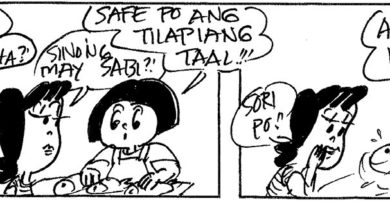ASEAN PAINTINGS: MANILA – The process itself is the art – Images by Pinggot Zulueta
The technical knowledge and skill with which Jason Moss approaches his work do not rob his oeuvre of heart
.
.
The development of the human condition, and how culture, world events, and personal experiences form our being,” says Jason Moss when asked about what drives him. Moss is a painter, illustrator, teacher, and avid participant of art collectives and his versatility is hardly news. His many disciplines notwithstanding, he specializes in traversing the complexity of the human experience.
“I am primarily an artist,” he says. “I believe it is my core, and that’s what I apply when I assume any role.” He says that it’s about applying what one has observed as an individual. “Apply the same analysis, summarize, then formulate the current mood or psyche of the human condition into concepts,” he says. “Relate it to your approach in art: to be an observer and mirror it; create visual opinions, reactions, or whatever you want to call your final output.” The product, Moss emphasizes, is but a shell. “The process itself is the art,” he explains, “and the artist is a mere conduit.”
.

Sagrada Pamilya, oil on canvas, 2015
.
The technical knowledge and skill with which Moss approaches his work do not rob his oeuvre of heart. Exploring themes of time, place, spirituality, and gender and spotlighting socio/political and gender related issues through figurative and object-based subject matters has led to a rich portfolio showcasing the different dimensions of his art. “I feel there’s still a lot for me to do,” Moss says. “I challenge myself by studying more and experimenting with more materials and processes. I guess it’s natural to be hard on yourself until you unravel your full potential.”
His restlessness is evident in his move to try his hand at various mediums, noting that he feels as though he has not “fully exploited the capabilities of acrylic.” “I know it’s not as much in the spotlight as oil,” he says. Currently Moss is rediscovering a different purpose for painting by looking at the way it behaves.
.

Dirty Laundry, digital on photo, 2017
.
Moss’s philosophy is simple: “Be limitless with ideas, always be curious, and practice art making every day.” This has bled into his creative process, which is methodical, ritualistic, yet spontaneous. “It can be all at the same time or a combination of any,” he says, admitting that it is near impossible to pinpoint a routine in terms of thought process. “Any subject that I come up with for a painting could just be triggered by a word, an experience, a color, a person. It varies.”
A constant in his process is walking through the hall of books in his house before making himself coffee, reading titles as he goes, lifting words, and putting them together, similar to coming up with titles for his piece. Sometimes, he zeroes in on a single, unfamiliar word and researches, until “one thing leads to another.” “This bit of information leads to different channels, exposing myriad subjects you’re curious to learn about,” he says. Some are knee-jerk reactions concerning accumulated social issues or studied behavior, leading to decisions to either make it into a painting, or a sculpture, or an installation. Humor is also central to the works of Moss. “Mine is a savage life most have never heard of,” he remarked, “so why stress about it when you can make fun of it?”
.

The Tasaday Daily- A Stoned Age, acrylic on canvas, 2017
.
The latest example of this process can be seen in his recent group show with the “Durian Collective.” Aside from the collaborative murals, each artist showcased an individual piece from their previous engagement at the field museum in Chicago when they were tasked to come up with paintings that had anthropological elements. “The piece that I made, Sagrada Familia (Sacred Family),” reflected on current events in my family,” Moss said. “They each represent a family member, painted in warm and minimal colors, borrowing native symbols from the north, relics from the south.” The pieces, he says, were laid out to form a compass, alluding to the ability to find the way home, and home itself, where family resides. Other works include identical pieces from an ongoing series. These, says Moss, are recycled pieces from one of his plates where he animated an Amorsolo market scene that exploded as homage to the Davao Public Market bombing.
Reflecting on the evolution of the Philippine art scene since he became a regular fixture years ago, Moss says that scene has evolved its consciousness, diversity, and ideas, with each artist contributing to the richness of various themes and subjects. “I think it’s exciting,” he said. “The real wealth of any country is its artists.”
The Manila Bulletin / Published By Hannah Jo Uy
.












